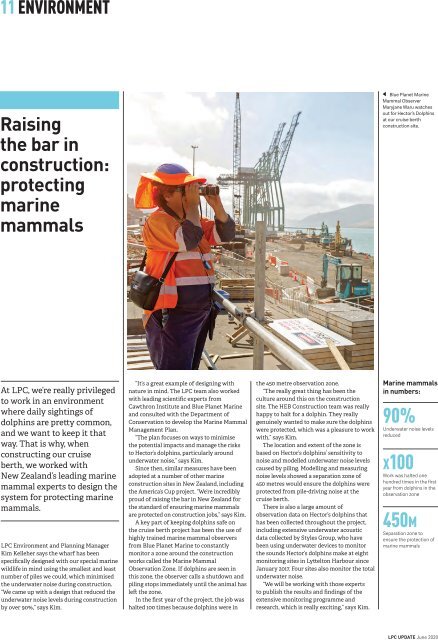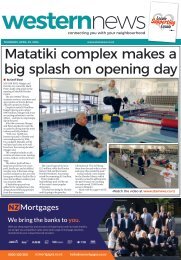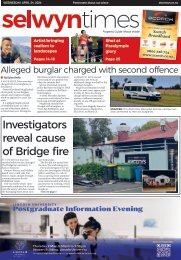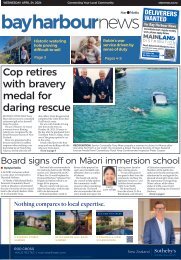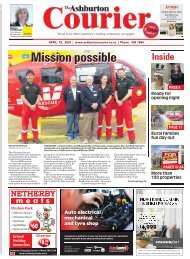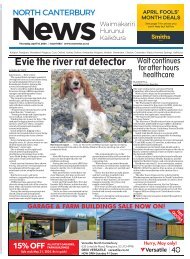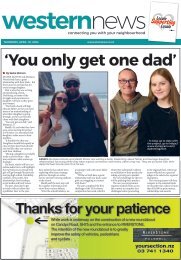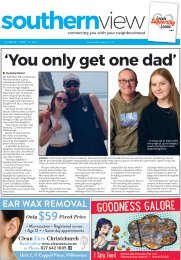Bay Harbour: June 24, 2020
You also want an ePaper? Increase the reach of your titles
YUMPU automatically turns print PDFs into web optimized ePapers that Google loves.
11 ENVIRONMENT<br />
LPC UPDATE <strong>June</strong> <strong>2020</strong><br />
Raising<br />
the bar in<br />
construction:<br />
protecting<br />
marine<br />
mammals<br />
Blue Planet Marine<br />
Mammal Observer<br />
Maryjane Waru watches<br />
out for Hector’s Dolphins<br />
at our cruise berth<br />
construction site.<br />
At LPC, we’re really privileged<br />
to work in an environment<br />
where daily sightings of<br />
dolphins are pretty common,<br />
and we want to keep it that<br />
way. That is why, when<br />
constructing our cruise<br />
berth, we worked with<br />
New Zealand’s leading marine<br />
mammal experts to design the<br />
system for protecting marine<br />
mammals.<br />
LPC Environment and Planning Manager<br />
Kim Kelleher says the wharf has been<br />
specifically designed with our special marine<br />
wildlife in mind using the smallest and least<br />
number of piles we could, which minimised<br />
the underwater noise during construction.<br />
“We came up with a design that reduced the<br />
underwater noise levels during construction<br />
by over 90%,” says Kim.<br />
“It’s a great example of designing with<br />
nature in mind. The LPC team also worked<br />
with leading scientific experts from<br />
Cawthron Institute and Blue Planet Marine<br />
and consulted with the Department of<br />
Conservation to develop the Marine Mammal<br />
Management Plan.<br />
“The plan focuses on ways to minimise<br />
the potential impacts and manage the risks<br />
to Hector’s dolphins, particularly around<br />
underwater noise,” says Kim.<br />
Since then, similar measures have been<br />
adopted at a number of other marine<br />
construction sites in New Zealand, including<br />
the America’s Cup project. “We’re incredibly<br />
proud of raising the bar in New Zealand for<br />
the standard of ensuring marine mammals<br />
are protected on construction jobs,” says Kim.<br />
A key part of keeping dolphins safe on<br />
the cruise berth project has been the use of<br />
highly trained marine mammal observers<br />
from Blue Planet Marine to constantly<br />
monitor a zone around the construction<br />
works called the Marine Mammal<br />
Observation Zone. If dolphins are seen in<br />
this zone, the observer calls a shutdown and<br />
piling stops immediately until the animal has<br />
left the zone.<br />
In the first year of the project, the job was<br />
halted 100 times because dolphins were in<br />
the 450 metre observation zone.<br />
“The really great thing has been the<br />
culture around this on the construction<br />
site. The HEB Construction team was really<br />
happy to halt for a dolphin. They really<br />
genuinely wanted to make sure the dolphins<br />
were protected, which was a pleasure to work<br />
with,” says Kim.<br />
The location and extent of the zone is<br />
based on Hector’s dolphins’ sensitivity to<br />
noise and modelled underwater noise levels<br />
caused by piling. Modelling and measuring<br />
noise levels showed a separation zone of<br />
450 metres would ensure the dolphins were<br />
protected from pile-driving noise at the<br />
cruise berth.<br />
There is also a large amount of<br />
observation data on Hector’s dolphins that<br />
has been collected throughout the project,<br />
including extensive underwater acoustic<br />
data collected by Styles Group, who have<br />
been using underwater devices to monitor<br />
the sounds Hector’s dolphins make at eight<br />
monitoring sites in Lyttelton <strong>Harbour</strong> since<br />
January 2017. Four sites also monitor the total<br />
underwater noise.<br />
“We will be working with those experts<br />
to publish the results and findings of the<br />
extensive monitoring programme and<br />
research, which is really exciting,” says Kim.<br />
Marine mammals<br />
in numbers:<br />
90%<br />
Underwater noise levels<br />
reduced<br />
X100<br />
Work was halted one<br />
hundred times in the first<br />
year from dolphins in the<br />
observation zone<br />
450M<br />
Separation zone to<br />
ensure the protection of<br />
marine mammals


